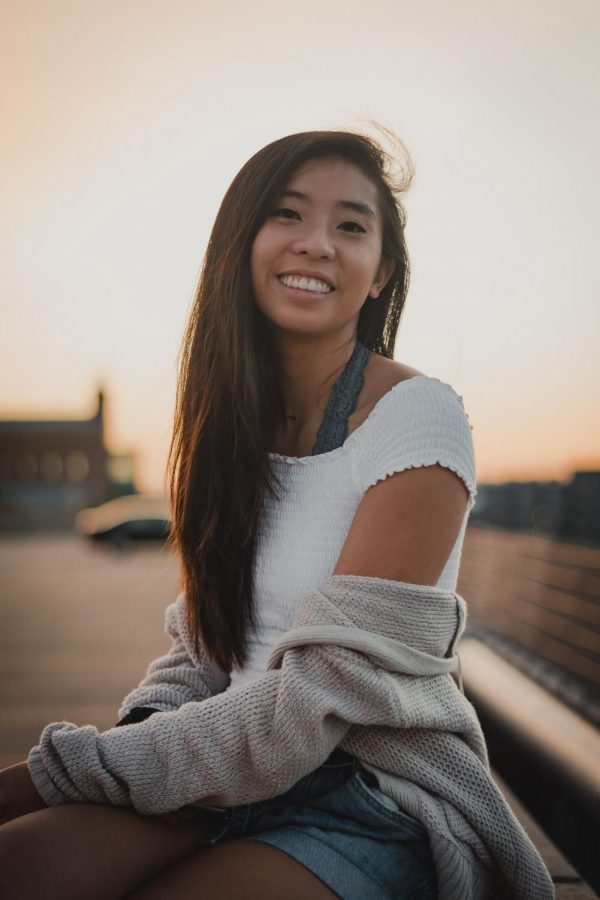Student teachers adapt to pandemic in classrooms
Seventh-grade student teacher Tammy Seto poses for a professional headshot. Seto works at Urbana Middle School and has had to adapt her teaching strategies to the COVID-19 pandemic.
March 11, 2021
Tammy Seto, senior in Education, remembers how she fell in love with teaching. Her little sister Tiffany was her first student.
“My sister and I would always play house, but instead of house, we would play school,” Seto said. “I would always be the teacher.”
Seto traded play-teaching for tutoring as she and her sister got older. When she got to college, her choice of major was easy — it was only a question of what she would teach. Now Seto is a student teacher for a seventh-grade science class at Urbana Middle School.
Twice a week, Seto teaches full days in person. She spends the rest of the week working remotely. This split schedule allows her precious pockets of free time between classes, teaching and her part-time front desk job.
“In a normal year, I would just be stressed out,” Seto said. “I wouldn’t even have time to socialize.”
Get The Daily Illini in your inbox!
While Seto is grateful for this flexibility, student-teaching in the pandemic has posed new problems. She is particularly concerned about keeping her students motivated.
Seto said she estimates about half of her class have failing grades. Struggling students are prioritized for in-person learning, but this system can create a difficult dynamic in the classroom.
“Those are already kids that don’t even want to be there in the first place, so those interactions between teachers and students are not what you would see in a normal year,” Seto said.
Seto and her cooperating teacher Ashley Dodson have made moves to help engagement. They look for online resources that simulate the hands-on experience of a science lab. They give out “behavior points” for jobs well done, which students can redeem for fun prizes — from their candy of choice to teacher TikToks.
Dodson is thankful to be navigating this transition with a dedicated and creative student teacher like Seto.
“I love working with Tammy,” Dodson said. “She’s one of the best student teachers I’ve had from U of I in a really long time.”
Dodson is in her seventh year teaching at Urbana Middle School. She completed her master’s degree in Education Policy, Organization and Leadership at the University last spring.
When Dodson’s graduate program went virtual, she realized the demands of online learning. She is proud of how her own students have taken on these challenges.
“We’ve thrown so much at them,” Dodson said. “Having to keep a schedule, having to be cognizant of your time — being responsible for all those pieces is not something we would normally expect from a middle schooler.”
Despite the tough adjustment, Dodson said she feels hopeful about online learning. Online resources make it easier to translate texts, so multilingual students can learn in their language of choice. Online platforms also allow her students to attempt assignments again and again, so they can make mistakes until things start to make sense.
Dodson said this kind of experimentation and revision is an important quality of science as a discipline. She hopes her students will carry this attitude beyond her classroom.
“We learn so much by trial and error,” Dodson said. “I want to help them see the benefit of messing up, and how it’s just a step in the learning process.”
At local high schools, students and teachers are feeling their way through a similar process.
David Farrell, senior in LAS, is a student teacher at Centennial High School. He spent a semester studying civil engineering before changing his major to English with a Secondary Education minor.
“I realized English was my passion,” Farrell said. “I thought teaching would be a really good way to share that.”
Like Seto’s seventh-graders, Farrell’s students are feeling the frustrations of virtual learning. Attendance is a problem and the kids who do come to class are often too drained to participate.
“Getting kids to even just talk to each other over Zoom is really hard to do,” Farrell said.
Farrell doesn’t see this issue of engagement as a student problem. Instead, he sees an opportunity for teachers to construct a more compelling curriculum and a more caring classroom.
In his freshman classes, Farrell and his cooperating teacher are leading a unit on disability studies, and Farrell has been moved by the students’ eager and honest participation.
“It’s one of the rare times that kids will actually unmute themselves,” he said. “I’m proud to have been a part of that and to give them an opportunity to talk about their own lives and things that matter to them.”
At the beginning of March, Centennial High School transitioned into a hybrid learning model. Farrell now makes the trip to the classroom four days a week.
Over halfway into the school year, he has begun to put faces to the names.
“It was really good to hear their voices and to see a little bit more of their personalities,” Farrell said. “They’d just been black boxes for so long.”







